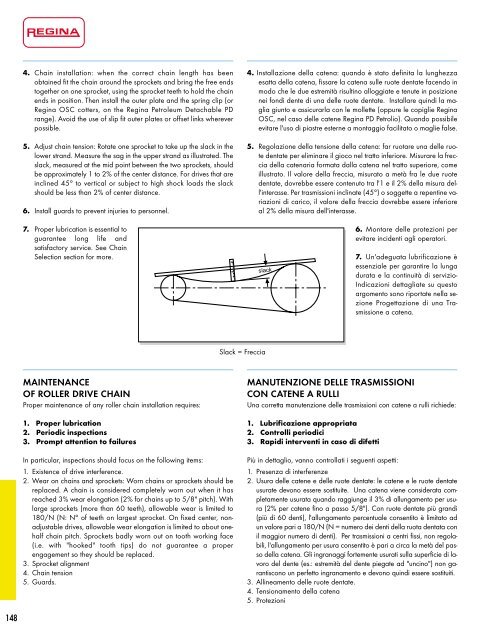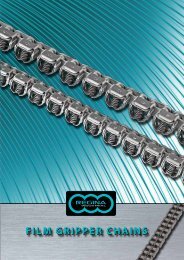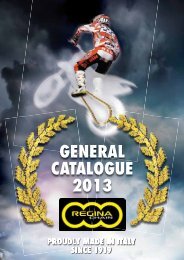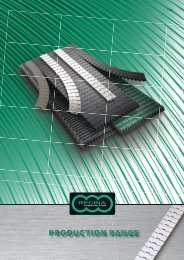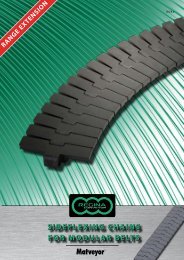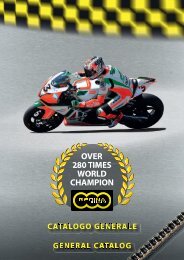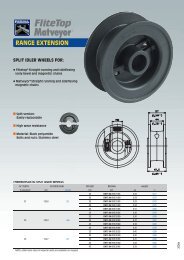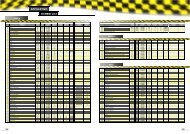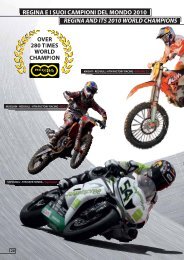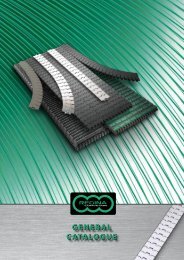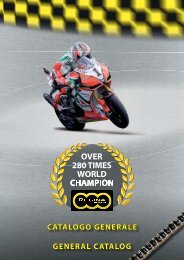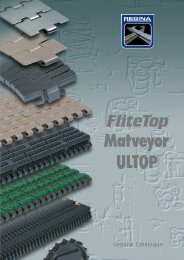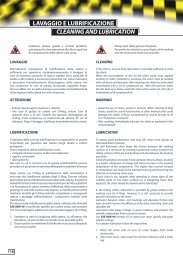Catalogo Generale Industrial - Regina
Catalogo Generale Industrial - Regina
Catalogo Generale Industrial - Regina
Create successful ePaper yourself
Turn your PDF publications into a flip-book with our unique Google optimized e-Paper software.
4. Chain installation: when the correct chain length has beenobtained fit the chain around the sprockets and bring the free endstogether on one sprocket, using the sprocket teeth to hold the chainends in position. Then install the outer plate and the spring clip (or<strong>Regina</strong> OSC cotters, on the <strong>Regina</strong> Petroleum Detachable PDrange). Avoid the use of slip fit outer plates or offset links whereverpossible.5. Adjust chain tension: Rotate one sprocket to take up the slack in thelower strand. Measure the sag in the upper strand as illustrated. Theslack, measured at the mid point between the two sprockets, shouldbe approximately 1 to 2% of the center distance. For drives that areinclined 45° to vertical or subject to high shock loads the slackshould be less than 2% of center distance.6. Install guards to prevent injuries to personnel.4. Installazione della catena: quando è stato definita la lunghezzaesatta della catena, fissare la catena sulle ruote dentate facendo inmodo che le due estremità risultino alloggiate e tenute in posizionenei fondi dente di una delle ruote dentate. Installare quindi la magliagiunto e assicurarla con le mollette (oppure le copiglie <strong>Regina</strong>OSC, nel caso delle catene <strong>Regina</strong> PD Petrolio). Quando possibileevitare l'uso di piastre esterne a montaggio facilitato o maglie false.5. Regolazione della tensione della catena: far ruotare una delle ruotedentate per eliminare il gioco nel tratto inferiore. Misurare la frecciadella catenaria formata dalla catena nel tratto superiore, comeillustrato. Il valore della freccia, misurato a metà fra le due ruotedentate, dovrebbe essere contenuto tra l'1 e il 2% della misura dell'interasse.Per trasmissioni inclinate (45°) o soggette a repentine variazionidi carico, il valore della freccia dovrebbe essere inferioreal 2% della misura dell'interasse.7. Proper lubrication is essential toguarantee long life andsatisfactory service. See ChainSelection section for more.slack6. Montare delle protezioni perevitare incidenti agli operatori.7. Un'adeguata lubrificazione èessenziale per garantire la lungadurata e la continuità di servizio-Indicazioni dettagliate su questoargomento sono riportate nella sezioneProgettazione di una Trasmissionea catena.Slack = FrecciaMAINTENANCEOF ROLLER DRIVE CHAINProper maintenance of any roller chain installation requires:1. Proper lubrication2. Periodic inspections3. Prompt attention to failuresIn particular, inspections should focus on the following items:1. Existence of drive interference.2. Wear on chains and sprockets: Worn chains or sprockets should bereplaced. A chain is considered completely worn out when it hasreached 3% wear elongation (2% for chains up to 5/8" pitch). Withlarge sprockets (more than 60 teeth), allowable wear is limited to180/N (N: N° of teeth on largest sprocket. On fixed center, nonadjustabledrives, allowable wear elongation is limited to about onehalfchain pitch. Sprockets badly worn out on tooth working face(i.e. with "hooked" tooth tips) do not guarantee a properengagement so they should be replaced.3. Sprocket alignment4. Chain tension5. Guards.MANUTENZIONE DELLE TRASMISSIONICON CATENE A RULLIUna corretta manutenzione delle trasmissioni con catene a rulli richiede:1. Lubrificazione appropriata2. Controlli periodici3. Rapidi interventi in caso di difettiPiù in dettaglio, vanno controllati i seguenti aspetti:1. Presenza di interferenze2. Usura delle catene e delle ruote dentate: le catene e le ruote dentateusurate devono essere sostituite. Una catena viene considerata completamenteusurata quando raggiunge il 3% di allungamento per usura(2% per catene fino a passo 5/8"). Con ruote dentate più grandi(più di 60 denti), l'allungamento percentuale consentito è limitato adun valore pari a 180/N (N = numero dei denti della ruota dentata conil maggior numero di denti). Per trasmissioni a centri fissi, non regolabili,l'allungamento per usura consentito è pari a circa la metà del passodella catena. Gli ingranaggi fortemente usurati sulla superficie di lavorodel dente (es.: estremità del dente piegate ad "uncino") non garantisconoun perfetto ingranamento e devono quindi essere sostituiti.3. Allineamento delle ruote dentate.4. Tensionamento della catena5. Protezioni148


